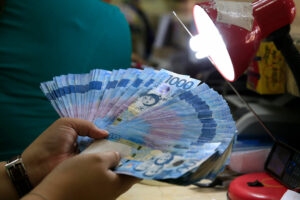




Quarterly Economic Growth Release: More BSP cuts to come
 DOWNLOAD
DOWNLOAD

Monthly Economic Update: Fed catches up
 DOWNLOAD
DOWNLOAD

Inflation Update: Steady and mellow
 DOWNLOAD
DOWNLOAD


NG outstanding debt slips to PHP 17.47T at end-August

The national government’s (NG) outstanding debt slipped to PHP 17.47 trillion at the end of August, but still remained above the full-year projection, data from the Bureau of the Treasury (BTr) showed.
The latest data from the Treasury showed outstanding debt dipped by 0.5% in August from the record-high PHP 17.56 trillion at end-July.
Despite the decline, the debt level is still 0.63% higher than the projected year-end level of PHP 17.36 trillion.
Year on year, NG debt jumped by 12.3% from PHP 15.55 trillion at the end of August 2024, the BTr said.
“This (debt reduction) was mainly due to the government’s full repayment of its biggest local bond for the year, worth PHP 516.34 billion, and a stronger peso, which reduced the value of the country’s external debt,” the BTr said.
NG debt is the total amount owed by the Philippine government to creditors such as international financial institutions, development partner-countries, banks, global bondholders and other investors.
In August, the bulk or 69.2% of the debt stock came from domestic sources, while external obligations made up the rest.
“The debt reduction was accompanied by an improvement in the country’s debt profile as the share of domestic debt to total borrowings increased to 69.2% from 68.9% in the previous month,” the BTr said.
A larger share of domestic borrowings in the country’s debt profile reflects “a generally more favorable debt position” as local debt is less vulnerable to shifts in foreign exchange movements, it added.
Domestic debt, which was composed of government securities, slid by 0.2% to PHP 12.09 trillion as of end-August from PHP 12.11 trillion as of end-July. It also rose by 12% annually from PHP 10.79 trillion in August last year.
This was already 0.35% higher than the PHP 12.04-trillion year-end domestic debt projection.
“Year to date, the NG raised PHP 1.84 trillion in gross domestic financing, including the highly successful issuance of Retail Treasury Bond Tranche 31 (RTB-31),” the BTr said.
On the other hand, external debt fell by 1.4% to PHP 5.38 trillion in August from PHP 5.46 trillion in the previous month. This also exceeded the PHP 5.32-trillion external debt projection this year by 1.24%.
“The reduction was attributed primarily to the effect of a stronger peso on external guarantees. Guaranteed obligations remained well-managed at only 2% of total NG debt,” the Treasury said.
Year on year, foreign debt climbed by 13.1% from PHP 4.76 trillion.
Foreign debt was composed mainly of PHP 2.74 trillion in global bonds and PHP 2.64 trillion in loans.
External debt securities were made up of PHP 2.32 trillion in US dollar bonds, PHP 253.39 billion in euro bonds, PHP 58.5 billion in Japanese yen bonds, PHP 57.04 billion in Islamic certificates and PHP 54.77 billion in peso global bonds.
For August, NG-guaranteed obligations slipped by 1.8% to PHP 346.46 billion from the end-July level of PHP 352.97 billion.
Year on year, it fell by 5.5% from PHP 366.57 billion.
Rizal Commercial Banking Corp. Chief Economist Michael L. Ricafort attributed the minimal monthly decline in outstanding debt to the net payments of large debt maturities.
“This is somewhat expected for large debt maturities paid to reduce outstanding debt but offset by new NG borrowings to finance the NG budget deficit,” he said in a Viber message.
In August, the BTr raised P507.16 billion through its RTB offering.
Mr. Ricafort warned that total outstanding debt may breach the government’s PHP 17.36-trillion projection by yearend, citing upcoming payments for maturing securities in September.
“(It) could still go up after payment of large NG debt maturities until September 2025,” Mr. Ricafort said.
John Paolo R. Rivera, a senior research fellow at the Philippine Institute for Development Studies, said the modest decline in debt may be temporary, citing scheduled repayments and favorable foreign exchange movements.
Mr. Rivera noted that NG debt remains 12.3% higher year on year and is likely to climb further, “likely staying above” PHP 17.4 trillion by yearend.
At the end of the second quarter, NG debt as a share of gross domestic product surged to 63.1%, the highest since 2005.
The Department of Finance expects the NG debt-to-GDP ratio to ease to 61.3% by end-2025 and eventually fall to 58% by 2030. — Aubrey Rose A. Inosante
This article originally appeared on bworldonline.com





 By BusinessWorld
By BusinessWorld
